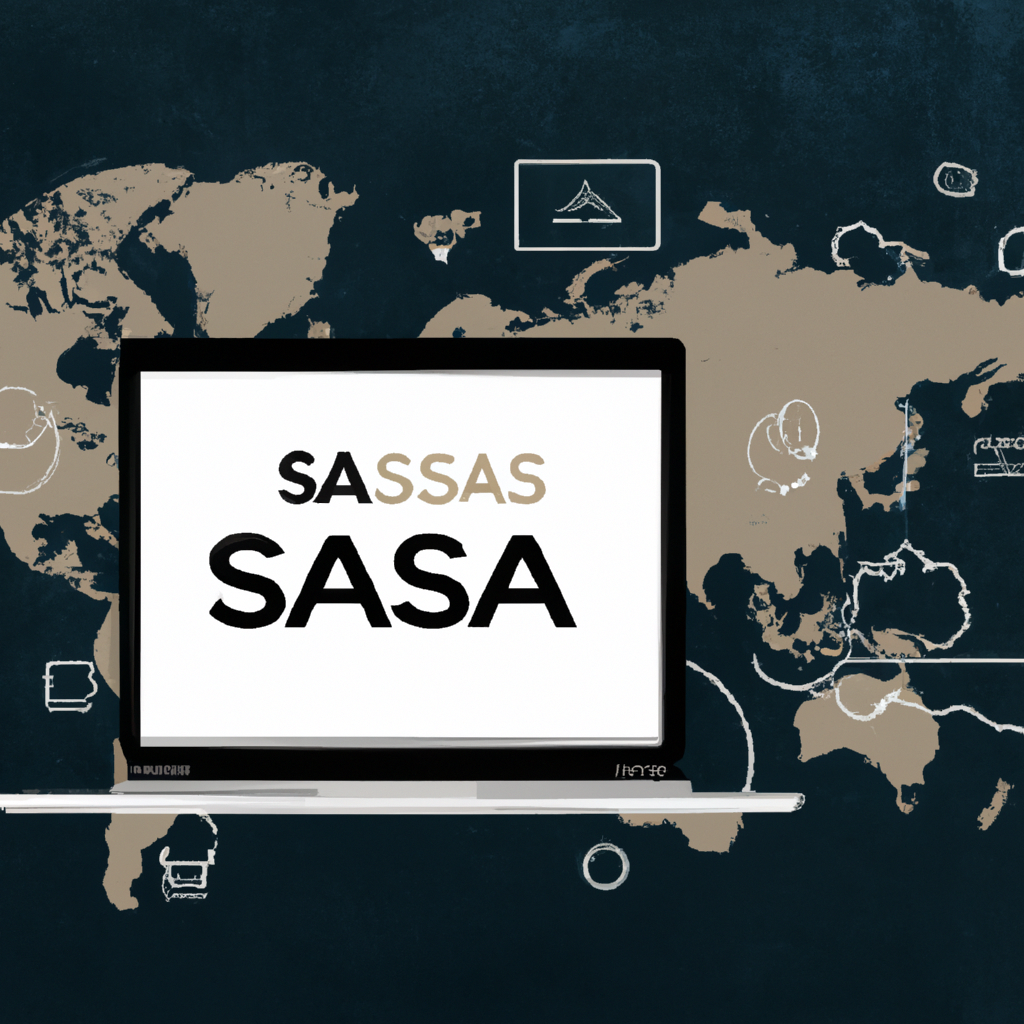Imagine a world where you don’t have to download, install, or constantly update software on your computer. Instead, you access everything you need through the internet, from any device, anywhere in the world. Sounds convenient, right? Well, that’s the power of Software as a Service (SaaS). In this article, we’ll explore the various scenarios where SaaS is commonly used, and how it’s revolutionizing the way businesses and individuals approach software. From enterprise resource planning to customer relationship management, you’ll discover the versatility and advantages of this cloud-based solution. So, get ready to uncover the many ways SaaS is changing the game.

This image is property of pixabay.com.
Collaborative Work
Collaborative work is an essential aspect of modern business environments. Whether you are working on a project, sharing documents, or communicating with your team, having efficient tools is crucial. SaaS (Software as a Service) offers a range of solutions to help streamline these collaborative work processes.
Project Management
SaaS project management tools provide a centralized platform for organizing and tracking projects. With features like task assignment, timelines, and progress tracking, these tools allow you to manage your projects more effectively. They also enable you to collaborate with team members, assign tasks, set deadlines, and monitor progress all in one place. Whether you are working on a small or large project, having a project management SaaS solution ensures all team members are on the same page and tasks are completed in a timely manner.
Document Sharing and Collaboration
Efficient document sharing and collaboration are essential for teams that work on shared documents, presentations, or spreadsheets. SaaS tools like Google Drive and Microsoft OneDrive provide a cloud-based platform for file storage and collaboration. With these tools, you can share documents with your team, collaborate in real-time, and track document changes. This streamlines the document creation and editing process, eliminates the need for multiple versions of documents, and ensures everyone has access to the latest version.
Team Communication
Effective team communication is crucial for the success of any project or business. SaaS communication tools such as Slack, Microsoft Teams, and Zoom provide instant messaging, video conferencing, and collaboration features. These tools enable team members to communicate in real-time, share files, and easily collaborate on projects. With features like group chats, channels, and video meetings, SaaS communication tools facilitate seamless communication within teams, regardless of geographic location.
Customer Relationship Management
A strong customer relationship management (CRM) strategy is essential for any business. SaaS CRM solutions provide comprehensive tools to manage and nurture customer relationships, streamline sales processes, and enhance customer support.
Sales Management
SaaS sales management tools help businesses streamline their sales processes by providing a centralized platform to track leads, manage customer interactions, and monitor sales performance. These tools enable sales teams to manage their pipeline, track deals, and generate accurate forecasts. With features like lead tracking, opportunity management, and sales analytics, SaaS sales management tools empower businesses to optimize their sales processes and increase revenue.
Lead Generation
Lead generation is a critical component of any business’s growth strategy. SaaS lead generation tools provide various features to help businesses identify and capture potential leads. These tools offer lead tracking, lead scoring, and lead nurturing capabilities. They also integrate with other marketing channels and analytics tools to provide a comprehensive view of lead generation efforts. With SaaS lead generation tools, businesses can automate and streamline their lead generation processes, saving time and resources.
Customer Support
Providing excellent customer support is crucial for maintaining customer satisfaction and loyalty. SaaS customer support tools provide a centralized platform to manage customer inquiries, track support tickets, and ensure timely resolution of customer issues. These tools offer features like ticket management, knowledge bases, and customer self-service options. With SaaS customer support tools, businesses can improve response times, enhance customer satisfaction, and ultimately build stronger customer relationships.

This image is property of pixabay.com.
Human Resources
Efficient human resources (HR) management is essential for attracting, hiring, and retaining the best talent. SaaS HR solutions offer a range of tools to streamline HR processes and improve overall employee management.
Recruitment and Onboarding
SaaS recruitment and onboarding tools help businesses streamline their hiring processes by automating candidate sourcing, applicant tracking, and onboarding procedures. These tools offer features like job posting, applicant tracking, and new hire onboarding checklists. By using SaaS recruitment and onboarding tools, businesses can save time, ensure a smooth onboarding experience, and make more informed hiring decisions.
Performance Management
Managing employee performance is vital for driving productivity and ensuring the success of any organization. SaaS performance management tools provide a centralized platform for setting goals, conducting performance evaluations, and tracking employee progress. These tools offer features like goal setting, performance reviews, and feedback mechanisms. With SaaS performance management tools, businesses can foster a culture of continuous improvement, provide feedback and recognition to employees, and align individual goals with organizational objectives.
Employee Training
Continuous employee training and development are crucial for enhancing skills and driving organizational growth. SaaS employee training tools offer learning management systems (LMS) that enable businesses to create, deliver, and track employee training programs. These tools provide features like course creation, employee enrollment, and training progress tracking. With SaaS employee training tools, businesses can ensure consistent and efficient training delivery, improve employee skill sets, and address any skills gaps within the organization.
Accounting and Finance
Efficient accounting and financial management are vital for the success of any business. SaaS accounting and finance solutions offer a range of tools to streamline financial processes, track expenses, and generate accurate financial reports.
Expense Management
Tracking and managing business expenses is essential for maintaining financial control and budget adherence. SaaS expense management tools provide features to track expenses, automate expense approvals, and generate expense reports. These tools enable businesses to streamline expense reimbursement processes, improve expense visibility, and ensure compliance with financial policies. With SaaS expense management tools, businesses can save time, reduce errors, and gain better control over their finances.
Invoicing and Billing
Timely and accurate invoicing and billing are critical for maintaining healthy cash flow and ensuring prompt payment from customers. SaaS invoicing and billing tools provide features to create and send invoices, track payment statuses, and generate financial reports. These tools also integrate with accounting software, enabling businesses to automate invoice creation, streamline billing processes, and improve overall financial management.
Financial Reporting
Generating accurate financial reports is vital for making informed business decisions and meeting regulatory requirements. SaaS financial reporting tools offer features to consolidate financial data, create customizable reports, and automate report generation. These tools provide businesses with real-time insights into their financial performance, enable easy comparison of financial data, and simplify the overall reporting process.

This image is property of pixabay.com.
Marketing and Advertising
Effective marketing and advertising strategies are crucial for attracting and retaining customers. SaaS marketing and advertising tools offer a range of features to streamline marketing efforts, manage social media platforms, and analyze campaign effectiveness.
Social Media Management
Managing social media platforms can be time-consuming and overwhelming. SaaS social media management tools provide features to schedule and publish posts, monitor social media activities, and analyze social media performance. These tools enable businesses to have a centralized platform for social media management, engage with their audience, and track the success of their social media campaigns.
Email Marketing
Email marketing remains a powerful tool for reaching and engaging with customers. SaaS email marketing tools offer features to create and send targeted email campaigns, track email performance, and automate email workflows. These tools enable businesses to personalize their email marketing efforts, segment their audience, and measure the effectiveness of their email campaigns. With SaaS email marketing tools, businesses can improve their email marketing ROI and enhance customer engagement.
Analytical Tools
Analyzing and understanding marketing data is crucial for optimizing marketing strategies and campaigns. SaaS analytical tools provide features to track website metrics, analyze campaign performance, and generate data-driven insights. These tools offer businesses the ability to measure the success of marketing efforts, identify areas for improvement, and make data-backed decisions to drive marketing ROI.
E-commerce
E-commerce has become a dominant force in the business world, and SaaS solutions offer various tools to manage online stores, track inventory, and streamline order processing.
Online Store Management
Managing an online store involves various tasks, including product listing, inventory management, and order fulfillment. SaaS online store management tools provide a platform to create and manage online stores, list products, and track sales. These tools offer features like inventory management, order tracking, and customer management. With SaaS online store management tools, businesses can create a seamless online shopping experience, manage inventory efficiently, and drive online sales.
Inventory Management
Efficient inventory management is crucial to ensure product availability and prevent stockouts. SaaS inventory management tools provide features to track inventory levels, manage stock replenishment, and provide real-time inventory visibility. These tools integrate with online stores and point-of-sale systems, enabling businesses to automate inventory updates and streamline order fulfillment processes. With SaaS inventory management tools, businesses can optimize their inventory levels, reduce carrying costs, and improve order accuracy.
Order Processing
Processing orders accurately and efficiently is essential for customer satisfaction and timely product delivery. SaaS order processing tools provide features to automate order management, track order status, and generate shipping labels. These tools integrate with online stores and payment gateways, enabling businesses to automate order processing workflows and streamline fulfillment processes. With SaaS order processing tools, businesses can minimize errors, improve order accuracy, and decrease order fulfillment time.

Education and Learning
The education and learning sector can benefit greatly from SaaS solutions, which offer tools to deliver online courses, manage student administration, and enhance learning experiences.
Learning Management Systems
Learning management systems (LMS) provide a digital platform for delivering and managing online courses and training programs. SaaS learning management systems offer features to create and deliver interactive courses, track student progress, and generate reports. These tools enable educational institutions and businesses alike to deliver a personalized and engaging learning experience, track learner performance, and provide continuous learning opportunities.
Online Courses and Training
SaaS online course and training tools offer features to create and deliver interactive and engaging online courses. These tools provide various content creation options, assessment capabilities, and student engagement features. With SaaS online course and training tools, educational institutions and businesses can reach a wider audience, deliver consistent training experiences, and track learner progress effectively.
Student Administration
Managing student administration processes is essential for educational institutions. SaaS student administration tools provide features to manage student records, track attendance, and automate administrative tasks. These tools offer centralized platforms for student data management, course registration, and fee management. With SaaS student administration tools, educational institutions can streamline administrative processes, enhance communication with students and parents, and ensure accurate student data management.
Healthcare
Efficient management of healthcare processes, patient records, and appointments is critical for the healthcare sector. SaaS solutions offer tools to streamline these workflows and ensure better patient care.
Electronic Health Records
SaaS electronic health records (EHR) systems enable healthcare providers to maintain and manage patient records electronically. These tools offer features to record patient information, track medical histories, and enhance data accessibility across healthcare facilities. With SaaS EHR systems, healthcare providers can improve patient care coordination, reduce administrative burden, and enhance patient safety through accurate and up-to-date records.
Patient Management
Efficient patient management processes are crucial for providing quality healthcare services. SaaS patient management tools provide features to schedule appointments, manage waiting lists, and track patient progress. These tools enable healthcare providers to optimize appointment scheduling, streamline patient flows, and improve patient experiences. With SaaS patient management tools, healthcare providers can ensure timely and personalized patient care, enhance staff productivity, and reduce patient waiting times.
Appointment Scheduling
Accurate and efficient appointment scheduling is essential for healthcare providers and patients alike. SaaS appointment scheduling tools provide features to automate appointment booking, manage appointment calendars, and send reminders. These tools enable healthcare providers to reduce scheduling errors, optimize appointment availability, and improve patient satisfaction by providing convenient and timely appointment options. With SaaS appointment scheduling tools, healthcare providers can enhance appointment management processes, minimize no-shows, and improve overall patient experiences.

IT and Software Development
SaaS solutions play a crucial role in the IT and software development industry, offering tools that streamline bug tracking, code management, and software deployment processes.
Bug Tracking and Issue Management
Identifying and resolving software bugs and issues is vital for ensuring the quality and functionality of software products. SaaS bug tracking and issue management tools provide features to track and manage software bugs and issues, assign tasks, and monitor progress. These tools enable software development teams to collaborate on bug fixes, track issue resolution timelines, and ensure a smooth development process. With SaaS bug tracking and issue management tools, software development teams can improve software quality, enhance developer productivity, and deliver more reliable products.
Code Repository
Code versioning and collaboration are essential for software development projects. SaaS code repository tools provide a centralized platform for managing and sharing code, enabling developers to collaborate effectively. These tools offer features like code versioning, branch management, and code review capabilities. With SaaS code repository tools, software development teams can ensure version control, maintain a single source of truth for code, and streamline collaboration among team members.
Continuous Integration and Deployment
Continuous integration and deployment (CI/CD) processes enable software development teams to deliver frequent code updates and new features. SaaS CI/CD tools provide features to automate code testing, build deployment pipelines, and monitor application performance. These tools enable software development teams to automate repetitive tasks, ensure code quality, and accelerate the software release cycle. With SaaS CI/CD tools, software development teams can effectively manage code deployments, reduce time-to-market, and improve overall application reliability.
Data Analysis
Making sense of data and extracting valuable insights is crucial for businesses in various industries. SaaS data analysis tools provide features to analyze and visualize data, enabling businesses to make data-driven decisions.
Business Intelligence
SaaS business intelligence tools offer features to collect, analyze, and visualize data from various sources. These tools provide dashboards, reports, and data visualization capabilities to help businesses gain insights into their operations and make informed decisions. With SaaS business intelligence tools, businesses can effectively analyze key performance indicators, identify trends, and monitor business performance in real-time.
Data Visualization
Presenting data visually is essential for effectively communicating complex information and trends. SaaS data visualization tools provide features to create interactive charts, graphs, and visualizations. These tools enable businesses to present data in a visually appealing and easy-to-understand manner, enhancing data comprehension and facilitating data-driven decision-making.
Data Mining
SaaS data mining tools enable businesses to extract valuable patterns and insights from large datasets. These tools provide features to discover hidden patterns, identify trends, and predict future outcomes. With SaaS data mining tools, businesses can enhance their understanding of customer behavior, optimize marketing strategies, and improve operations based on data-driven insights.
In conclusion, SaaS solutions offer a wide range of tools to streamline various business processes across different industries. From collaborative work platforms to customer relationship management, human resources, accounting and finance, marketing and advertising, e-commerce, education and learning, healthcare, IT and software development, and data analysis, SaaS applications provide efficient and accessible solutions that enhance productivity, improve decision-making, and drive success in today’s business landscape. Adopting SaaS solutions can empower businesses to optimize their processes, improve collaboration, and leverage data to stay competitive in their respective industries.
